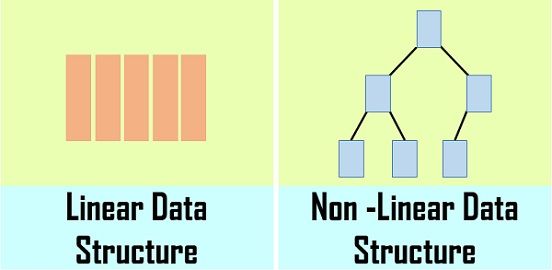 The data structure can be defined as the interpretation of logical relationship existing between the solitary elements of data. The linear and non-linear data structure is the subclassification of the data structure which comes under the Non-primitive data structure. The crucial difference between them is that the linear data structure arranges the data into a sequence and follow some sort of order. Whereas, the non-linear data structure does not organize the data in a sequential manner.
The data structure can be defined as the interpretation of logical relationship existing between the solitary elements of data. The linear and non-linear data structure is the subclassification of the data structure which comes under the Non-primitive data structure. The crucial difference between them is that the linear data structure arranges the data into a sequence and follow some sort of order. Whereas, the non-linear data structure does not organize the data in a sequential manner.
The linear data structure is a single level data structure while non-linear data structures are the multilevel data structure. The data structure priorly describes how the data is organised, accessed, associated and processed.
Content: Linear and Non-linear Data Structure
Comparison Chart
| Basis for comparison | Linear data structure | Non-linear data structure |
|---|---|---|
| Basic | The data items are arranged in an orderly manner where the elements are attached adjacently. | It arranges the data in a sorted order and there exists a relationship between the data elements. |
| Traversing of the data | The data elements can be accessed in one time (single run). | Traversing of data elements in one go is not possible. |
| Ease of implementation | Simpler | Complex |
| Levels involved | Single level | Multiple level |
| Examples | Array, queue, stack, linked list, etc. | Tree and graph. |
| Memory utilization | Ineffective | Effective |
Definition of Linear Data Structure
The data structure is considered to be linear if the data elements construct a sequence of a linear list. The elements are adjacently attached to each other and in a specified order. It consumes linear memory space, the data elements are required to store in a sequential manner in the memory. While implementing the linear data structure the necessary amount of memory is declared previously. It does not make a good utilization of memory and result in memory wastage. The data element are visited sequentially where only a single element can be directly reached.
The examples included in the linear data structure are array, stack, queue, linked list, etc. An array is a group of a definite number of homogeneous elements or data items. Stack and queue are also an ordered collection of the elements like an array but there is a special condition where stack follows LIFO (Last in first out) order and queue employ FIFO (First in first out) to insert and delete the elements. Lists can be defined as a set of variable number data items.
Definition of Non-linear Data Structure
Non-linear data structure does not arrange the data consecutively rather it is arranged in sorted order. In this, the data elements can be attached to more than one element exhibiting the hierarchical relationship which involves the relationship between the child, parent, and grandparent. In the non-linear data structure, the traversal of data elements and insertion or deletion are not done sequentially.
The non-linear data structure utilizes the memory efficiently and does not require the memory declaration in advance. There are the two common examples of the non-linear data structure – tree and graph. A tree data structure organizes and stores the data elements in a hierarchical relationship.
Key Differences Between Linear and Non-linear Data Structure
- In the linear data structure, the data is organized in a linear order in which elements are linked one after the other. As against, in the non-linear data structure the data elements are not stored in a sequential manner rather the elements are hierarchically related.
- The traversing of data in the linear data structure is easy as it can make all the data elements to be traversed in one go, but at a time only one element is directly reachable. On the contrary, in the non-linear data structure, the nodes are not visited sequentially and cannot be traversed in one go.
- Data elements are adjacently attached in the linear data structure, which means only two elements can be linked to two other elements while this is not the case in the non-linear data structure where one data element can be connected to numerous other elements.
- The linear data structures are easily implemented relative to the non-linear data structure.
- A single level of elements is incorporated in the linear data structure. Conversely, non-linear data structure involves multiple levels.
- Examples of the linear data structure are array, queue, stack, linked list, etc. In contrast, tree and graph are the examples of the non-linear data structure.
- The memory is utilized efficiently in the non-linear data structure where linear data structure tends to waste the memory.
Conclusion
The linear data structures involve a single level of data elements and represent the linear relationship. On the other hand, the non-linear data structure is said to be multi-level data structure constitute a hierarchical relationship among the data.
Satguru Gandash says
Thank you 😊